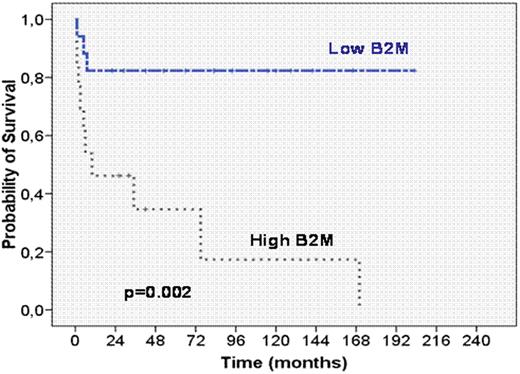Abstract
Abstract 1244
Poster Board I-266
Allogeneic stem cell transplantation (SCT) is the only curative treatment for chronic lymphocytic leukemia (CLL). Advanced age, extensive prior therapy, lack of response to treatment, and T-cell depletion of the graft are poor prognostic factors which have been identified in many studies. Beta-2 microglobulin (B2M) has important prognostic value in patients treated with chemotherapy or chemoimmunotherapy, but has been scarcely investigated in the context of allogeneic SCT. In two studies (Khouri et al. Cytotherapy 2002; Sorror et al. J Clin Oncol 2008) no correlation was found between B2M and transplant outcome. Against this background, we analyzed the influence of B2M and other prognostic parameters in 32 patients (median age 50 yrs [range, 29-63], 20 males) who received an allogeneic SCT in our institution between 1991 and 2006. Interval between diagnosis and transplantation was 44 months (range, 6-116). Median number of prior therapies was 2 (range, 1-6). Six patients had previously received an autologous SCT. Most patients had adverse biologic features (high ZAP-70 expression, unmutated IGHV, poor cytogenetics). Serum B2M was increased (≥2.5 mg/L) in 13 out of 29 patients prior to transplant. Creatinine levels and glomerular filtration rate were normal. Median follow-up after transplantation was 7 years (range, 1.8- 16.9). The relapse risk (RR) at 5 and 10 years was 5 % (95% CI, 0-14%) and 23% (95% CI, 2-44), respectively. At one and 10 years the cumulative non-relapse mortality (NRM) was 34% (95% CI, 17-51) and 38% (95% CI, 20-55), respectively. Five and 10-year progression free survival (PFS), event free survival (EFS) and overall survival (OS) were 85% (CI, 66-100) and 65% (CI, 35-94), 58% (CI, 40-76) and 40% (CI, 19-62), and 62% (CI, 45-79) and 57% (CI, 38-75). In the univariate analysis, factors associated with a higher NRM were prior autologous SCT (p=0.006), chemorefractory disease (p=0.04), and high serum B2M levels at the time of SCT (p=0.03). Parameters associated with EFS and OS were high B2M levels (p=0.001 and p=0.002), prior autologous SCT (p<0.001 and p=0.001), and number of prior lines of chemotherapy (≤ 1 vs. ≥ 2) (p=0.018 and p=0.042). In the multivariate analysis, prior autologous SCT (RR=4.4, CI: 1.2-16.3; p=0.02) and chemorefractory disease (RR=3.82, CI: 1.06-13.7; p=0.04) were associated with a higher NRM whereas B2M at the time of SCT was a strong independent factor associated with EFS (RR=5.34, CI: 1.7-16.6; p=0.004) and OS (RR=6.20, CI: 1.6-23; p=0.006). The figure shows the impact of B2M on survival after allogeneic SCT.
In contrast, IGHV mutational status, high ZAP-70 expression, > 30% bone marrow infiltration, and disease status (CR vs. no CR) at the time of SCT were not associated with outcome. In summary, this study indicates that, as in patients treated with chemo or chemoimmunotherapy, B2M is a strong predictor of clinical outcome in patients with CLL submitted to allogeneic SCT.
No relevant conflicts of interest to declare.
Author notes
Asterisk with author names denotes non-ASH members.


This feature is available to Subscribers Only
Sign In or Create an Account Close Modal